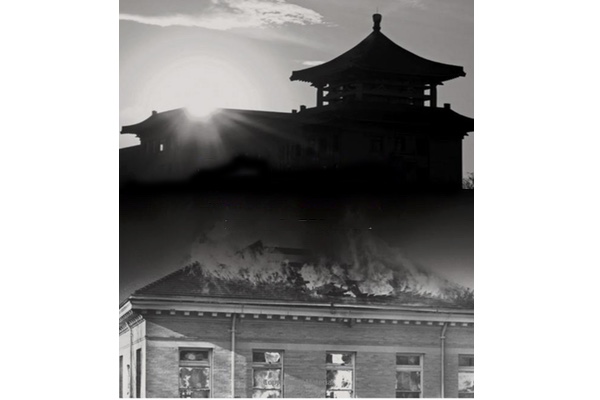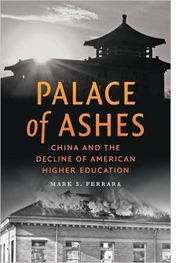Which Country Has Better High Ed System - China or the USA?

Those of us living in the United States, who have recently traveled to a major urban center in China (such as Chongqing, Shenzhen, or Shanghai), likely noted that the airplanes and airports, trains and train stations, are often superior to those back home. Behind that surprising feature of modern China are ongoing infrastructure investments made starting in the 1980s (in economic sectors such as manufacturing, transportation, agriculture, communications, information technology, and the service industries)—and they are paying handsome dividends in terms of rising national prosperity.
 Since
1978, the Chinese Communist Party has built the largest higher
educational system in the world with upwards of 30 million students;
its 2,400 institutions of higher learning produce roughly eight
million graduates per year, about five million more than American
colleges and universities. UCLA professor Robert Rhoads notes that
pride in these accomplishments mean that Chinese leaders expect that
their universities will “assume standing among the elite
universities of the world—the Harvards, Oxfords, and Stanfords,”
and they hold them accountable for “assisting in China’s economic
and social transformation.”
Since
1978, the Chinese Communist Party has built the largest higher
educational system in the world with upwards of 30 million students;
its 2,400 institutions of higher learning produce roughly eight
million graduates per year, about five million more than American
colleges and universities. UCLA professor Robert Rhoads notes that
pride in these accomplishments mean that Chinese leaders expect that
their universities will “assume standing among the elite
universities of the world—the Harvards, Oxfords, and Stanfords,”
and they hold them accountable for “assisting in China’s economic
and social transformation.”
While in the short term there may be little danger of preeminent American universities ceding their positions to the likes of Beijing, Qinghua, or Fudan, the Chinese desire to realize such a goal—and their willingness to provide the financial backing to make it a reality—is unmistakable. Equally apparent is the slow downward slide of higher education in the United States from its apex of influence and integrity during the mid-to-late twentieth century. In the last two-and-a-half decades, college degree attainment in other advanced industrial countries overtook that of the United States, as research output slowed, and the granting of doctoral degrees in STEM fields declined in absolute terms.
A thirty-year run of neoliberalism (a universalized logic of competition that justifies the transformation of institutions established for the public good into business enterprises) is depleting the American academy of its intellectual capital. The symptoms of that deterioration include the influx of corporate managerialism, administrative bloat, the erosion of shared governance, the near-disappearance of the tenure system, skyrocketing tuitions, the diminution of the humanities in favor of vocationally oriented STEM programs, and the deprofessionalization (or adjunctification) of the faculty as a cost-saving measure to compensate for exorbitant executive salaries.
It is not simply that we are gradually falling behind the rest of the world, but that the American academy has lost its way by jettisoning key features of its own historical and cultural heritage, including the disinterested pursuit of knowledge, academic freedom protected by tenure, and the importance of faculty oversight of the curriculum. Simultaneously, English-speaking countries, such as the United Kingdom and Australia, are siphoning off students and attracting faculty members—and rapidly industrializing nations are investing in infrastructure and human resources to create international (English-speaking) hubs of higher learning containing world-class institutions—super-research universities of international stature where faculty members consistently produce important scholarly output.
For this reason, the current supremacy of American colleges and universities on the world stage is largely a consequence of lingering perceptions of excellencethat no longer accord with reality. Before long, international students will realize that the majority of their American professors are part-time faculty members, paid wages that impoverish, who toil in environments that resemble factory floors or fast-food kitchens more than traditional institutions of higher learning. American scholars of note will also “vote with their feet” as universities in other countries offer higher salaries, better resources, superior infrastructure, the freedom to pursue pure (disinterested) research—and the students will follow.
The Chinese government clearly grasps this point; in 2008, it began the “One Hundred Talents” program to lure internationally renowned scientists and scholars to its flagship universities (and now offers them a “green card” for permanent residence). By 2020, Chinese leaders seek to further expand higher education enrollment to 40 million, institute a new decentralized governance structure, nurture regional university centers, and recruit eminent scholars (including Nobel laureates) into its top research institutions. Rui Yang observes that one of the most striking features of the Chinese situation, is a “strong commitment by both institutions and governments to the quest for world-class universities, something rarely found in most Western societies.”
The claim that the United States no longer enjoys the privileged status of unrivaled leader in global higher education may sound overstated to some readers, who might reference “measures of quality” such as research spending, patents, invention, and global rankings and see little threat of crisis. After all, the United States remains the destination of choice for international students and scholars—and it still boasts of more world-class universities than any other country. Indeed, but for how much longer?
Widening wage inequality in the United States, Thomas Piketty reminds us, is a consequence of a failure to sufficiently invest in higher education. Compounding that shortcoming, too many Americans are failing to receive the necessary educational training essential to personal and national advancement, because families cannot afford the high cost of tuition. As income determines access to higher education, social mobility will further decline. According to Piketty, the best way to increase wages and reduce wage inequality is to invest in educational skills (a winning formula that the Chinese government followed for decades).
In sum, although it retains a reputation for excellence built up during the interval between the Second World War and early 1980s, the once-fabled American university is falling into disrepair (mirroring the decrepit state of the country’s infrastructure). While a facile analogy, the fact that one may travel from Beijing on the eastern seaboard to Lhasa on the remote Tibetan Plateau by train in 44 hours—and that travel times between many major Chinese cities have been halved in recent years—is nevertheless most revealing. For the sake of contrast, the Amtrak Northeast Corridor will nearly halve travel times between New York and Washington, a distance of less than 300 miles, by 2040.
In recent months, sweeping drops in Chinese stock prices, accompanied by currency revaluation, underscores the pain that the Chinese economy will endure transitioning from a manufacturing to a knowledge base. As GDP growth decelerates below 7 percent, it will test the Chinese people’s tolerance for one party rule and raise the specter of social unrest. The student protests in Hong Kong during 2014 serve as a compelling reminder of the formidable appeal of democracy in East Asia.
Not withstanding these and other challenges faced by China, Columbia University sociologist Jonathan Cole points out that Asian nations “have come to realize the enormous social and economic returns that come from a highly trained workforce and from a set of universities that produce world-class research.” Leaders in China understand that most jobs in today’s knowledge economy require tertiary education, that angling to attract human capital is essential to the formation of international hubs of learning, and that demand for international higher education will continue to grow as students become more mobile.
Given China’s intentions to become an uncontested leader in international higher education, and the patterns of global convergence that bolster those plans, the United States stands to allow its last great export to slip away. As these trends take firm shape in the coming decades, they will become apparent to American educators, policymakers, and politicians, who still have an opportunity to respond appropriately—as they did in the 1950s and 1960s, when research universities rose to the technological challenge that the success of the Russian Sputnik satellite represented, and became shining beacons of innovation and democracy.